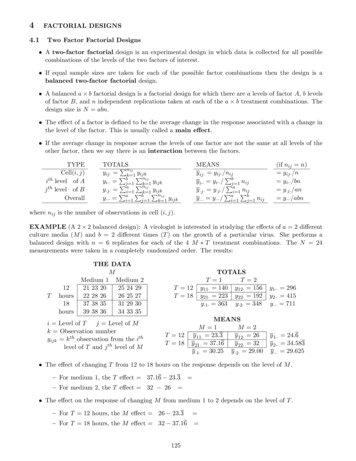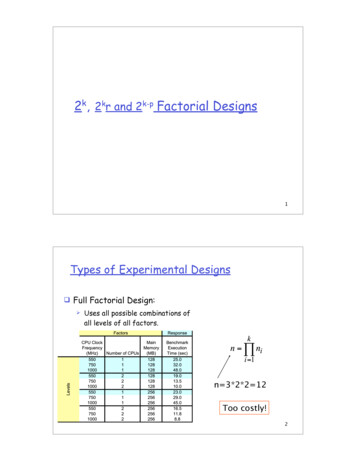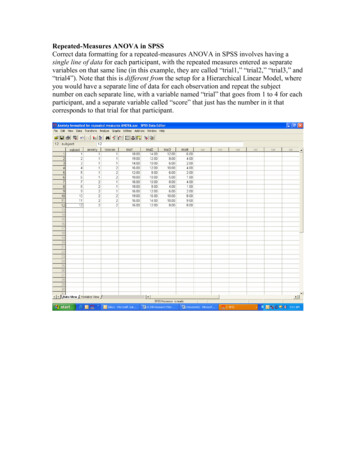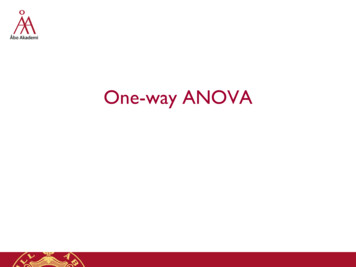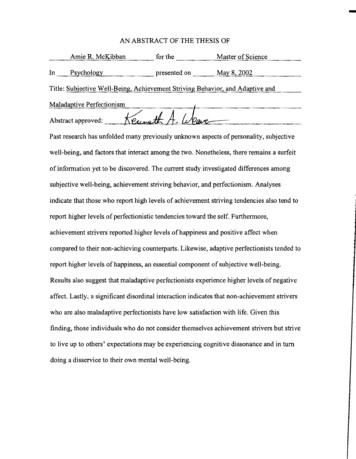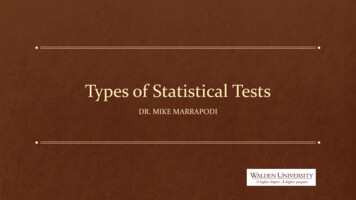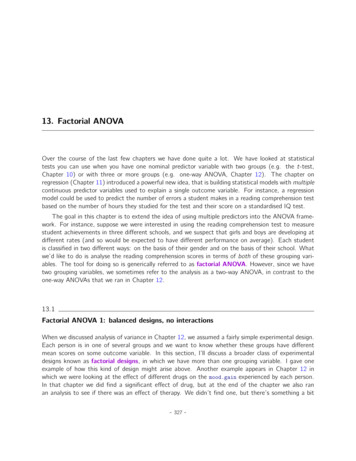
Transcription
13. Factorial ANOVAOver the course of the last few chapters we have done quite a lot. We have looked at statisticaltests you can use when you have one nominal predictor variable with two groups (e.g. the t-test,Chapter 10) or with three or more groups (e.g. one-way ANOVA, Chapter 12). The chapter onregression (Chapter 11) introduced a powerful new idea, that is building statistical models with multiplecontinuous predictor variables used to explain a single outcome variable. For instance, a regressionmodel could be used to predict the number of errors a student makes in a reading comprehension testbased on the number of hours they studied for the test and their score on a standardised IQ test.The goal in this chapter is to extend the idea of using multiple predictors into the ANOVA framework. For instance, suppose we were interested in using the reading comprehension test to measurestudent achievements in three different schools, and we suspect that girls and boys are developing atdifferent rates (and so would be expected to have different performance on average). Each studentis classified in two different ways: on the basis of their gender and on the basis of their school. Whatwe’d like to do is analyse the reading comprehension scores in terms of both of these grouping variables. The tool for doing so is generically referred to as factorial ANOVA. However, since we havetwo grouping variables, we sometimes refer to the analysis as a two-way ANOVA, in contrast to theone-way ANOVAs that we ran in Chapter 12.13.1Factorial ANOVA 1: balanced designs, no interactionsWhen we discussed analysis of variance in Chapter 12, we assumed a fairly simple experimental design.Each person is in one of several groups and we want to know whether these groups have differentmean scores on some outcome variable. In this section, I’ll discuss a broader class of experimentaldesigns known as factorial designs, in which we have more than one grouping variable. I gave oneexample of how this kind of design might arise above. Another example appears in Chapter 12 inwhich we were looking at the effect of different drugs on the mood.gain experienced by each person.In that chapter we did find a significant effect of drug, but at the end of the chapter we also ranan analysis to see if there was an effect of therapy. We didn’t find one, but there’s something a bit- 327 -
worrying about trying to run two separate analyses trying to predict the same outcome. Maybe thereactually is an effect of therapy on mood gain, but we couldn’t find it because it was being “hidden”by the effect of drug? In other words, we’re going to want to run a single analysis that includes bothdrug and therapy as predictors. For this analysis each person is cross-classified by the drug they weregiven (a factor with 3 levels) and what therapy they received (a factor with 2 levels). We refer to thisas a 3 ˆ 2 factorial design.If we cross-tabulate drug by therapy, using the ‘Frequencies’ - ‘Contingency Tables’ analysis inJASP (see Section 9.2), we get the table shown in Figure 13.1Figure 13.1: JASP contingency table of drug by therapy.As you can see, not only do we have participants corresponding to all possible combinations ofthe two factors, indicating that our design is completely crossed, it turns out that there are an equalnumber of people in each group. In other words, we have a balanced design. In this section I’lltalk about how to analyse data from balanced designs, since this is the simplest case. The story forunbalanced designs is quite tedious, so we’ll put it to one side for the moment.13.1.1What hypotheses are we testing?Like one-way ANOVA, factorial ANOVA is a tool for testing certain types of hypotheses aboutpopulation means. So a sensible place to start would be to be explicit about what our hypothesesactually are. However, before we can even get to that point, it’s really useful to have some cleanand simple notation to describe the population means. Because of the fact that observations arecross-classified in terms of two different factors, there are quite a lot of different means that onemight be interested in. To see this, let’s start by thinking about all the different sample means thatwe can calculate for this kind of design. Firstly, there’s the obvious idea that we might be interestedin this list of group means:- 328 -
000Now, this output shows a list of the group means for all possible combinations of the two factors(e.g., people who received the placebo and no therapy, people who received the placebo while gettingCBT, etc.). It is helpful to organise all these numbers, plus the row and column means and the overallmean, into a single table which looks like this:placeboanxifreejoyzepamtotalno 50.721.480.88Now, each of these different means is of course a sample statistic. It’s a quantity that pertainsto the specific observations that we’ve made during our study. What we want to make inferencesabout are the corresponding population parameters. That is, the true means as they exist within somebroader population. Those population means can also be organised into a similar table, but we’ll needa little mathematical notation to do so. As usual, I’ll use the symbol µ to denote a population mean.However, because there are lots of different means, I’ll need to use subscripts to distinguish betweenthem.Here’s how the notation works. Our table is defined in terms of two factors. Each row correspondsto a different level of Factor A (in this case drug), and each column corresponds to a different level ofFactor B (in this case therapy). If we let R denote the number of rows in the table, and C denote thenumber of columns, we can refer to this as an R ˆ C factorial ANOVA. In this case R “ 3 and C “ 2.We’ll use lowercase letters to refer to specific rows and columns, so µr c refers to the population meanassociated with the r th level of Factor A (i.e. row number r ) and the cth level of Factor B (columnnumber c).1 So the population means are now written like this:placeboanxifreejoyzepamtotalno therapyµ11µ21µ311CBTµ12µ22µ32totalThe nice thing about the subscript notation is that it generalises nicely. If our experiment had involved a third factor,then we could just add a third subscript. In principle, the notation extends to as many factors as you might care toinclude, but in this book we’ll rarely consider analyses involving more than two factors, and never more than three.- 329 -
Okay, what about the remaining entries? For instance, how should we describe the average mood gainacross the entire (hypothetical) population of people who might be given Joyzepam in an experimentlike this, regardless of whether they were in CBT? We use the “dot” notation to express this. Inthe case of Joyzepam, notice that we’re talking about the mean associated with the third row in thetable. That is, we’re averaging across two cell means (i.e., µ31 and µ32 ). The result of this averagingis referred to as a marginal mean, and would be denoted µ3. in this case. The marginal mean forCBT corresponds to the population mean associated with the second column in the table, so we usethe notation µ.2 to describe it. The grand mean is denoted µ. because it is the mean obtained byaveraging (marginalising2 ) over both. So our full table of population means can be written down likethis:placeboanxifreejoyzepamtotalno .µ2.µ3.µ.Now that we have this notation, it is straightforward to formulate and express some hypotheses.Let’s suppose that the goal is to find out two things. First, does the choice of drug have any effect onmood? And second, does CBT have any effect on mood? These aren’t the only hypotheses that wecould formulate of course, and we’ll see a really important example of a different kind of hypothesis inSection 13.2, but these are the two simplest hypotheses to test, and so we’ll start there. Consider thefirst test. If the drug has no effect then we would expect all of the row means to be identical, right?So that’s our null hypothesis. On the other hand, if the drug does matter then we should expect theserow means to be different. Formally, we write down our null and alternative hypotheses in terms ofthe equality of marginal means:Null hypothesis, H0 :Alternative hypothesis, H1 :row means are the same, i.e., µ1. “ µ2. “ µ3.at least one row mean is different.It’s worth noting that these are exactly the same statistical hypotheses that we formed when weran a one-way ANOVA on these data back in Chapter 12. Back then I used the notation µP to referto the mean mood gain for the placebo group, with µA and µJ corresponding to the group means forthe two drugs, and the null hypothesis was µP “ µA “ µJ . So we’re actually talking about the samehypothesis, it’s just that the more complicated ANOVA requires more careful notation due to thepresence of multiple grouping variables, so we’re now referring to this hypothesis as µ1. “ µ2. “ µ3. .However, as we’ll see shortly, although the hypothesis is identical the test of that hypothesis is subtlydifferent due to the fact that we’re now acknowledging the existence of the second grouping variable.2Technically, marginalising isn’t quite identical to a regular mean. It’s a weighted average where you take into accountthe frequency of the different events that you’re averaging over. However, in a balanced design, all of our cell frequenciesare equal by definition so the two are equivalent. We’ll discuss unbalanced designs later, and when we do so you’ll seethat all of our calculations become a real headache. But let’s ignore this for now.- 330 -
Speaking of the other grouping variable, you won’t be surprised to discover that our second hypothesis test is formulated the same way. However, since we’re talking about the psychological therapyrather than drugs our null hypothesis now corresponds to the equality of the column means:Null hypothesis, H0 :Alternative hypothesis, H1 :13.1.2column means are the same, i.e., µ.1 “ µ.2column means are different, i.e., µ.1 ‰ µ.2Running the analysis in JASPThe null and alternative hypotheses that I described in the last section should seem awfully familiar.They’re basically the same as the hypotheses that we were testing in our simpler one-way ANOVAs inChapter 12. So you’re probably expecting that the hypothesis tests that are used in factorial ANOVAwill be essentially the same as the F -test from Chapter 12. You’re expecting to see references tosums of squares (SS), mean squares (MS), degrees of freedom (df), and finally an F -statistic that wecan convert into a p-value, right? Well, you’re absolutely and completely right. So much so that I’mgoing to depart from my usual approach. Throughout this book, I’ve generally taken the approachof describing the logic (and to an extent the mathematics) that underpins a particular analysis firstand only then introducing the analysis in JASP. This time I’m going to do it the other way aroundand show you how to do it in JASP first. The reason for doing this is that I want to highlight thesimilarities between the simple one-way ANOVA tool that we discussed in Chapter 12, and the morecomplicated approach that we’re going to use in this chapter.If the data you’re trying to analyse correspond to a balanced factorial design then running youranalysis of variance is easy. To see how easy it is, let’s start by reproducing the original analysis fromChapter 12. In case you’ve forgotten, for that analysis we were using only a single factor (i.e., drug)to predict our outcome variable (i.e., mood.gain), and we got the results shown in Figure 13.2.Figure 13.2: JASP one way ANOVA of mood.gain by drug.Now, suppose I’m also curious to find out if therapy has a relationship to mood.gain. In lightof what we’ve seen from our discussion of multiple regression in Chapter 11, you probably won’t besurprised that all we have to do is add therapy as a second ‘Fixed Factor’ in the analysis, see Figure13.3.- 331 -
Figure 13.3: JASP two way ANOVA of mood.gain by drug and therapy.This output is pretty simple to read too. The first row of the table reports a between-group sumof squares (SS) value associated with the drug factor, along with a corresponding between-group dfvalue. It also calculates a mean square value (MS), an F -statistic and a p-value. There is also a rowcorresponding to the therapy factor and a row corresponding to the residuals (i.e., the within groupsvariation).Not only are all of the individual quantities pretty familiar, the relationships between these differentquantities has remained unchanged, just like we saw with the original one-way ANOVA. Note that themean square value is calculated by dividing SS by the corresponding df . That is, it’s still true thatMS “SSdfregardless of whether we’re talking about drug, therapy or the residuals. To see this, let’s not worryabout how the sums of squares values are calculated. Instead, let’s take it on faith that JASP hascalculated the SS values correctly, and try to verify that all the rest of the numbers make sense. First,note that for the drug factor, we divide 3.453 by 2 and end up with a mean square value of 1.727. Forthe therapy factor, there’s only 1 degree of freedom, so our calculations are even simpler: dividing0.467 (the SS value) by 1 gives us an answer of 0.467 (the MS value).Turning to the F statistics and the p values, notice that we have two of each; one correspondingto the drug factor and the other corresponding to the therapy factor. Regardless of which one we’retalking about, the F statistic is calculated by dividing the mean square value associated with the factorby the mean square value associated with the residuals. If we use “A” as shorthand notation to referto the first factor (factor A; in this case drug) and “R” as shorthand notation to refer to the residuals,then the F statistic associated with factor A is denoted FA , and is calculated as follows:FA “MSAMSRand an equivalent formula exists for factor B (i.e., therapy). Note that this use of “R” to refer toresiduals is a bit awkward, since we also used the letter R to refer to the number of rows in the table,- 332 -
but I’m only going to use “R” to mean residuals in the context of SSR and MSR , so hopefully thisshouldn’t be confusing. Anyway, to apply this formula to the drugs factor we take the mean squareof 1.727 and divide it by the residual mean square value of 0.066, which gives us an F -statistic of26.149. The corresponding calculation for the therapy variable would be to divide 0.467 by 0.066which gives 7.076 as the F -statistic. Not surprisingly, of course, these are the same values that JASPhas reported in the ANOVA table above.Also in the ANOVA table is the calculation of the p values. Once again, there is nothing newhere. For each of our two factors what we’re trying to do is test the null hypothesis that there is norelationship between the factor and the outcome variable (I’ll be a bit more precise about this lateron). To that end, we’ve (apparently) followed a similar strategy to what we did in the one way ANOVAand have calculated an F -statistic for each of these hypotheses. To convert these to p values, all weneed to do is note that the sampling distribution for the F statistic under the null hypothesis (thatthe factor in question is irrelevant) is an F distribution. Also note that the two degrees of freedomvalues are those corresponding to the factor and those corresponding to the residuals. For the drugfactor we’re talking about an F distribution with 2 and 14 degrees of freedom (I’ll discuss degrees offreedom in more detail later). In contrast, for the therapy factor the sampling distribution is F with1 and 14 degrees of freedom.At this point, I hope you can see that the ANOVA table for this more complicated factorialanalysis should be read in much the same way as the ANOVA table for the simpler one way analysis.In short, it’s telling us that the factorial ANOVA for our 3 ˆ 2 design found a significant effect of drug(F2,14 “ 26.15, p † .001) as well as a significant effect of therapy (F1,14 “ 7.08, p “ .02). Or, to usethe more technically correct terminology, we would say that there are two main effects of drug andtherapy. At the moment, it probably seems a bit redundant to refer to these as “main” effects, but itactually does make sense. Later on, we’re going to want to talk about the possibility of “interactions”between the two factors, and so we generally make a distinction between main effects and interactioneffects.13.1.3How are the sum of squares calculated?In the previous section I had two goals. Firstly, to show you that the JASP method needed to dofactorial ANOVA is pretty much the same as what we used for a one way ANOVA. The only differenceis the addition of a second factor. Secondly, I wanted to show you what the ANOVA table looks likein this case, so that you can see from the outset that the basic logic and structure behind factorialANOVA is the same as that which underpins one way ANOVA. Try to hold onto that feeling. It’sgenuinely true, insofar as factorial ANOVA is built in more or less the same way as the simpler one-wayANOVA model. It’s just that this feeling of familiarity starts to evaporate once you start digging intothe details. Traditionally, this comforting sensation is replaced by an urge to hurl abuse at the authorsof statistics textbooks.Okay, let’s start by looking at some of those details. The explanation that I gave in the last sectionillustrates the fact that the hypothesis tests for the main effects (of drug and therapy in this case)- 333 -
are F -tests, but what it doesn’t do is show you how the sum of squares (SS) values are calculated.Nor does it tell you explicitly how to calculate degrees of freedom (df values) though that’s a simplething by comparison. Let’s assume for now that we have only two predictor variables, Factor A andFactor B. If we use Y to refer to the outcome variable, then we would use Yr ci to refer to the outcomeassociated with the i -th member of group r c (i.e., level/row r for Factor A and level/column c forFactor B). Thus, if we use Ȳ to refer to a sample mean, we can use the same notation as before torefer to group means, marginal means and grand means. That is, Ȳr c is the sample mean associatedwith the r th level of Factor A and the cth level of Factor B, Ȳr. would be the marginal mean for ther th level of Factor A, Ȳ.c would be the marginal mean for the cth level of Factor B, and Ȳ. is thegrand mean. In other words, our sample means can be organised into the same table as the populationmeans. For our clinical trial data, that table looks like this:no therapy CBT joyzepamȲ31Ȳ32Ȳ3.totalȲ.1Ȳ.2Ȳ.And if we look at the sample means that I showed earlier, we have Ȳ11 “ 0.30, Ȳ12 “ 0.60 etc. In ourclinical trial example, the drugs factor has 3 levels and the therapy factor has 2 levels, and so whatwe’re trying to run is a 3 ˆ 2 factorial ANOVA. However, we’ll be a little more general and say thatFactor A (the row factor) has R levels and Factor B (the column factor) has C levels, and so whatwe’re runnning here is an R ˆ C factorial ANOVA.Now that we’ve got our notation straight, we can compute the sum of squares values for each ofthe two factors in a relatively familiar way. For Factor A, our between group sum of squares iscalculated by assessing the extent to which the (row) marginal means Ȳ1. , Ȳ2. etc, are different fromthe grand mean Ȳ. . We do this in the same way that we did for one-way ANOVA: calculate the sumof squared difference between the Ȳi. values and the Ȳ. values. Specifically, if there are N people ineach group, then we calculate thisSSA “ pN ˆ CqRÿ r “1Ȳr. Ȳ. 2 2As with one-way ANOVA, the most interestinga part of this formula is the Ȳr. Ȳ. bit, whichcorresponds to the squared deviation associated with level r . All that this formula does is calculatethis squared deviation for all R levels of the factor, add them up, and then multiply the result byN ˆ C. The reason for this last part is that there are multiple cells in our design that have level ron Factor A. In fact, there are C of them, one corresponding to each possible level of Factor B! For- 334 -
instance, in our example there are two different cells in the design corresponding to the anxifreedrug: one for people with no.therapy and one for the CBT group. Not only that, within each ofthese cells there are N observations. So, if we want to convert our SS value into a quantity thatcalculates the between-groups sum of squares on a “per observation” basis, we have to multiply byN ˆ C. The formula for factor B is of course the same thing, just with some subscripts shuffledaroundCÿ 2SSB “ pN ˆ RqȲ.c Ȳ.c“1Now that we have these formulas we can check them against the JASP output from the earliersection. Once again, a dedicated spreadsheet programme is helpful for these sorts of calculations.First, let’s calculate the sum of squares associated with the main effect of drug. There are atotal of N “ 3 people in each group and C “ 2 different types of therapy. Or, to put it anotherway, there are 3 ˆ 2 “ 6 people who received any particular drug. When we do these calculations ina spreadsheet programme, we get a value of 3.45 for the sum of squares associated with the maineffect of drug. Not surprisingly, this is the same number that you get when you look up the SS valuefor the drugs factor in the ANOVA table that I presented earlier, in Figure 13.3.We can repeat the same kind of calculation for the effect of therapy. Again there are N “ 3people in each group, but since there are R “ 3 different drugs, this time around we note that thereare 3 ˆ 3 “ 9 people who received CBT and an additional 9 people who received the placebo. Soour calculation in this case gives us a value of 0.47 for the sum of squares associated with the maineffect of therapy. Once again, we are not surprised to see that our calculations are identical to theANOVA output in Figure 13.3.So that’s how you calculate the SS values for the two main effects. These SS values areanalogous to the between-group sum of squares values that we calculated when doing one-wayANOVA in Chapter 12. However, it’s not a good idea to think of them as between-groups SSvalues anymore, just because we have two different grouping variables and it’s easy to get confused.In order to construct an F test, however, we also need to calculate the within-groups sum ofsquares. In keeping with the terminology that we used in the regression chapter (Chapter 11) andthe terminology that JASP uses when printing out the ANOVA table, I’ll start referring to thewithin-groups SS value as the residual sum of squares SSR .The easiest way to think about the residual SS values in this context, I think, is to think of itas the leftover variation in the outcome variable after you take into account the differences in themarginal means (i.e., after you remove SSA and SSB ). What I mean by that is we can start bycalculating the total sum of squares, which I’ll label SST . The formula for this is pretty much thesame as it was for one-way ANOVA. We take the difference between each observation Yr ci and thegrand mean Ȳ. , square the differences, and add them all upSST “R ÿC ÿNÿ r “1 c“1 i“1- 335 -Yr ci Ȳ. 2
The “triple summation” here looks more complicated than it is. In the first two summations, we’resumming across all levels of Factor A (i.e., over all possible rows r in our table) and across all levelsof Factor B (i.e., all possible columns c). Each r c combination corresponds to a single group andeach group contains N people, so we have to sum across all those people (i.e., all i values) too. Inother words, all we’re doing here is summing across all observations in the data set (i.e., all possibler ci combinations).At this point, we know the total variability of the outcome variable SST , and we know how muchof that variability can be attributed to Factor A (SSA ) and how much of it can be attributed toFactor B (SSB ). The residual sum of squares is thus defined to be the variability in Y that can’t beattributed to either of our two factors. In other wordsSSR “ SST pSSA SSB qOf course, there is a formula that you can use to calculate the residual SS directly, but I think thatit makes more conceptual sense to think of it like this. The whole point of calling it a residual is thatit’s the leftover variation, and the formula above makes that clear. I should also note that, in keepingwith the terminology used in the regression chapter, it is commonplace to refer to SSA SSB asthe variance attributable to the “ANOVA model”, denoted SSM , and so we often say that the totalsum of squares is equal to the model sum of squares plus the residual sum of squares. Later on inthis chapter we’ll see that this isn’t just a surface similarity: ANOVA and regression are actually thesame thing under the hood.In any case, it’s probably worth taking a moment to check that we can calculate SSR using thisformula and verify that we do obtain the same answer that JASP produces in its ANOVA table.Again, the calculations are pretty straightforward when done in a spreadsheet. We can calculate thetotal SS using the formulas above (getting an answer of total SS 4.85) and then the residual SS( 0.92). Yet again, we get the same answer.aEnglish translation: “least tedious”.13.1.4What are our degrees of freedom?The degrees of freedom are calculated in much the same way as for one-way ANOVA. For anygiven factor, the degrees of freedom is equal to the number of levels minus 1 (i.e., R 1 for the rowvariable Factor A, and C 1 for the column variable Factor B). So, for the drugs factor we obtaindf “ 2, and for the therapy factor we obtain df “ 1. Later on, when we discuss the interpretationof ANOVA as a regression model (see Section 13.6), I’ll give a clearer statement of how we arriveat this number. But for the moment we can use the simple definition of degrees of freedom, namelythat the degrees of freedom equals the number of quantities that are observed, minus the number ofconstraints. So, for the drugs factor, we observe 3 separate group means, but these are constrainedby 1 grand mean, and therefore the degrees of freedom is 2. For the residuals, the logic is similar,but not quite the same. The total number of observations in our experiment is 18. The constraints- 336 -
correspond to 1 grand mean, the 2 additional group means that the drug factor introduces, and the1 additional group mean that the the therapy factor introduces, and so our degrees of freedom is 14.As a formula, this is N 1 pR 1q pC 1q, which simplifies to N R C 1.13.1.5Factorial ANOVA versus one-way ANOVAsNow that we’ve seen how a factorial ANOVA works, it’s worth taking a moment to compare it tothe results of the one way analyses, because this will give us a really good sense of why it’s a goodidea to run the factorial ANOVA. In Chapter 12, I ran a one-way ANOVA that looked to see if thereare any differences between drugs, and a second one-way ANOVA to see if there were any differencesbetween therapies. As we saw in Section 13.1.1, the null and alternative hypotheses tested by theone-way ANOVAs are in fact identical to the hypotheses tested by the factorial ANOVA. Looking evenmore carefully at the ANOVA tables, we can see that the sum of squares associated with the factorsare identical in the two different analyses (3.45 for drug and 0.92 for therapy), as are the degrees offreedom (2 for drug, 1 for therapy). But they don’t give the same answers! Most notably, when weran the one-way ANOVA for therapy in Section 12.10 we didn’t find a significant effect (the p-valuewas .21). However, when we look at the main effect of therapy within the context of the two-wayANOVA, we do get a significant effect (p “ .019). The two analyses are clearly not the same.Why does that happen? The answer lies in understanding how the residuals are calculated. Recallthat the whole idea behind an F -test is to compare the variability that can be attributed to a particularfactor with the variability that cannot be accounted for (the residuals). If you run a one-way ANOVAfor therapy, and therefore ignore the effect of drug, the ANOVA will end up dumping all of the druginduced variability into the residuals! This has the effect of making the data look more noisy thanthey really are, and the effect of therapy which is correctly found to be significant in the two-wayANOVA now becomes non-significant. If we ignore something that actually matters (e.g., drug) whentrying to assess the contribution of something else (e.g., therapy) then our analysis will be distorted.Of course, it’s perfectly okay to ignore variables that are genuinely irrelevant to the phenomenon ofinterest. If we had recorded the colour of the walls, and that turned out to be a non-significantfactor in a three-way ANOVA, it would be perfectly okay to disregard it and just report the simplertwo-way ANOVA that doesn’t include this irrelevant factor. What you shouldn’t do is drop variablesthat actually make a difference!13.1.6What kinds of outcomes does this analysis capture?The ANOVA model that we’ve been talking about so far covers a range of different patterns thatwe might observe in our data. For instance, in a two-way ANOVA design there are four possibilities:(a) only Factor A matters, (b) only Factor B matters, (c) both A and B matter, and (d) neither A- 337 -
2.5O
placebo no.therapy 0.300000 anxifree no.therapy 0.400000 joyzepam no.therapy 1.466667 placebo CBT 0.600000 anxifree CBT 1.033333 joyzepam CBT 1.500000 Now, this output shows a list of the group means for all possible combinations of the two factors (e.g., people who received the placebo and no therapy, people who received the placebo while getting
